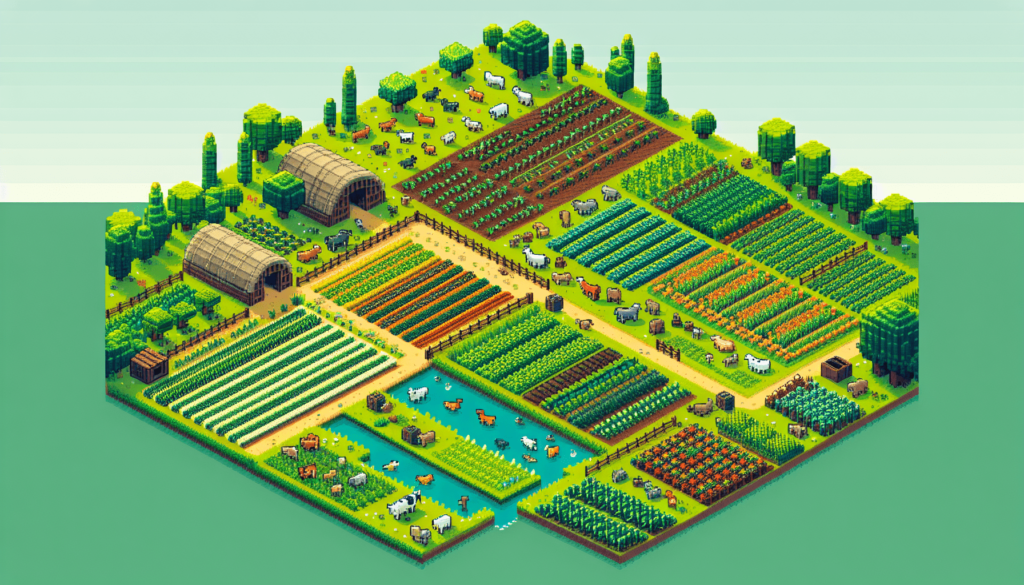Minecraft Farm
Step into the wonderful world of “Minecraft Farm” where creativity and relaxation meet. In this immersive virtual experience, players get to cultivate their own bountiful farms, complete with a variety of crops, adorable animals, and charming farm buildings. Whether you have a green thumb or are just looking for a peaceful and enjoyable way to spend your time, “Minecraft Farm” offers endless possibilities for creating your agricultural haven. Get ready to embark on a farming adventure like no other, where the only limit is your imagination.
Introduction to Minecraft Farming
Definition of Minecraft Farming
In the world of Minecraft, farming refers to the cultivation of crops, the breeding of animals, and the harvesting of various resources to sustain ourselves and progress in the game. It involves creating and maintaining different types of farms, using various techniques and strategies to optimize production. Whether it’s growing crops, raising animals, or farming mobs, the art of farming in Minecraft is a crucial aspect of gameplay.
Importance of Farming in Minecraft
Farming is essential in Minecraft for several reasons. Firstly, it provides a sustainable food source, allowing us to keep hunger at bay and maintain our health. It also enables us to obtain valuable resources such as wood, crops, and animal products, which we can use for various purposes like crafting, trading, and building. Furthermore, farming plays a vital role in progression, as it allows us to acquire experience points, earn achievements, and unlock new possibilities in the game.
Types of Farms in Minecraft
There are several types of farms that we can create in Minecraft, each serving a different purpose. Crop farms are used to grow various plants and crops like wheat, carrots, potatoes, melons, pumpkins, and sugarcane. These farms require careful planning, irrigation systems, and proper lighting to ensure optimal growth. Animal farms, on the other hand, focus on breeding and raising animals such as cows, pigs, sheep, and chickens to obtain their drops and products. Finally, mob farms are designed to exploit the spawning mechanics of hostile mobs, allowing us to farm them for rare drops and experience points.
Crops and Plants in Minecraft
Basic Crops (Wheat, Carrots, Potatoes)
Wheat is one of the fundamental crops in Minecraft. It can be used to craft bread, breed animals, and trade with villagers. Carrots and potatoes, on the other hand, serve as alternative food sources and can also be used to breed pigs and rabbits. These basic crops require tilled soil, water, and light to grow, making them relatively easy to cultivate.
Special Crops (Melons, Pumpkins, Sugar Canes)
Melons and pumpkins are special crops that have unique growth patterns. Melons grow in patches on farmland and can be harvested into melon slices. Pumpkins, on the other hand, require an adjacent block of farmland to grow and can be harvested to obtain pumpkins and pumpkin seeds. Sugar canes are another special crop that grows near water and can be harvested for sugar, paper, or used in crafting various items.
Trees and Wood Production
Trees play a crucial role in Minecraft as a valuable source of wood and other resources. Different tree types, such as oak, spruce, birch, acacia, and jungle, yield different types of wood, each with its distinct properties and appearances. Wood is an essential material for crafting tools, items, and building structures. By strategically planting and harvesting trees, we can ensure a steady supply of wood and sustainably manage our resource needs.
Flowers and Dye Farming
Flowers in Minecraft serve both decorative and functional purposes. Some flowers, such as roses, dandelions, and sunflowers, can be used as decoration, while others, like blue orchids and lilies of the valley, can be used to craft dyes for coloring various items. By creating flower farms, we can ensure a constant supply of flowers for our building projects and dye needs.

Animal Husbandry in Minecraft
Types of Animals (Cows, Pigs, Sheep, Chickens)
Minecraft offers a variety of animals that we can breed and raise on our farms. Cows are a common livestock choice, providing beef, leather, and milk. Pigs offer porkchops and can be ridden with a saddle. Sheep provide wool and can be dyed different colors for aesthetic purposes. Chickens lay eggs, which can be used for food or crafting. Each animal has its unique drops and uses, making them valuable additions to our farms.
Breeding and Farming Animals
To breed animals in Minecraft, we can use various methods depending on the animal type. For cows, we can feed them wheat to induce breeding. Pigs can be bred with carrots, sheep with wheat, and chickens with seeds. By creating suitable enclosures and maintaining a steady supply of food, we can ensure the continuous breeding and growth of our animal population.
Animal Drops and Uses
The drops obtained from farm animals have numerous uses in Minecraft. Beef can be cooked into steaks for a readily available food source. Leather is used for crafting armor, books, and item frames. Porkchops provide another source of meat, while wool from sheep is essential for creating carpets, beds, and banners. Chickens not only provide feathers and raw chicken for crafting arrows and food but also lay eggs, which can be used to hatch baby chickens or create cakes.
Mob Farming in Minecraft
Overview of Mob Farming
Mob farming involves creating structures or systems to farm hostile mobs for their drops and experience points. This can range from simple farms that exploit natural mob spawning to complex contraptions that use spawners found in dungeons or mineshafts. Mob farming is a rewarding endeavor as it allows us to collect valuable resources such as gunpowder, bones, string, arrows, and even rare items like Ender pearls and Wither skeleton skulls.
Spawning Mechanisms (Spawner vs. Natural)
There are two main spawning mechanisms for mobs in Minecraft: spawner-based and natural spawning. Spawners are found in dungeons, mineshafts, and Nether fortresses and can be used to create farm structures where mobs continuously spawn. Natural spawning, on the other hand, occurs in specific conditions, such as low light levels or specific biomes. By understanding these mechanisms, we can design and build efficient mob farms to maximize our drops and experience points.
Defensive Measures for Mob Farms
Mob farms can be dangerous places, as hostile mobs pose a threat to our survival. It’s essential to implement defensive measures to ensure our safety while operating these farms. This can include building protective barriers, using water channels to flush mobs into collection points, creating drop chutes for ease of collection, and installing lighting systems to prevent mob spawning in unwanted areas. By taking these precautions, we can farm mobs effectively without endangering ourselves.

Automatic Farms in Minecraft
Benefits of Automatic Farms
Automatic farms offer several advantages over manual farming. They allow us to save time and effort by automating the process of planting, growing, and harvesting crops or breeding and collecting animal products. Automatic farms also provide a consistent and continuous supply of resources, making them ideal for large-scale production or resource gathering. With proper design and implementation, automatic farms can significantly enhance our gameplay experience.
Redstone Contraptions for Automation
Redstone, a Minecraft-specific material, is crucial for creating mechanisms and contraptions that facilitate automation on farms. Redstone can be used to power pistons, dispensers, hoppers, and other devices, enabling us to create intricate systems for automatic farming. By utilizing redstone circuits, we can design mechanisms that control the flow of water, activate dispensers for planting or harvesting, and even control animal breeding and collection. Redstone contraptions bring a whole new level of automation to our Minecraft farms.
Efficient Crop Harvesting Systems
Efficient crop harvesting systems are essential for maximizing the yield of our farms. One commonly used method is the use of water channels or pistons to harvest crops automatically. When triggered, water can flush crops into a collection area, where they can be easily gathered. Another technique involves using dispensers with bonemeal to instantly grow crops to their full size, allowing for quick and efficient harvesting. By implementing these systems, we can streamline our crop harvesting process and ensure a bountiful harvest.
Automatic Animal Collection
Automating the collection of animal products is another aspect of automatic farming. By designing systems that use water currents, hoppers, and chests, we can create a setup that automatically collects items dropped by animals, such as eggs, feathers, and meats. This eliminates the need for manual collection and allows us to focus on other aspects of our farm while still reaping the benefits of animal farming. Automatic animal collection saves time, resources, and effort, making it a valuable addition to any Minecraft farm.
Challenges and Tips for Successful Minecraft Farming
Managing Limited Resources
One of the challenges of Minecraft farming is managing limited resources effectively. It’s crucial to balance our resource needs with sustainable practices to ensure the longevity of our farms. Carefully planning our crop layouts, utilizing renewable resources like bone meal for faster growth, and optimizing animal breeding to prevent overcrowding are essential strategies for managing limited resources.
Avoiding Overcrowding and Lag
Overcrowding can lead to increased entity count in the game, which can cause lag and performance issues. It’s essential to design farms with appropriate space and capacity to prevent overcrowding of animals and crops. Additionally, utilizing efficient breeding processes, such as separating animals into different enclosures or using automated breeding systems, can help us maintain a sustainable population without overwhelming our game’s performance.
Dealing with Crop Growth and Grading
Crop growth and grading can pose challenges, especially when dealing with large-scale farming operations. To ensure even growth and efficient harvesting, it’s important to create irrigation systems that provide water to all crops, utilize proper lighting to prevent crop decay, and implement systems for grading crops based on growth stages. By organizing crops based on their growth progress, we can optimize our harvesting process and maximize our crop yield.
Implementing Efficient Storage Systems
As our farms grow, the need for efficient storage systems becomes crucial. Proper organization and storage of harvested crops, animal products, and other resources ensure easy access and prevent clutter. Utilizing chests, barrels, and hoppers in designated storage areas can help us maintain a clean and organized farm. Sorting systems with hoppers and item filters can also be implemented to automatically sort items into their respective storage units, further enhancing efficiency.

Farming Techniques for Different Minecraft Versions
Farming in Survival Mode
Survival mode presents its own set of challenges when it comes to farming. In survival mode, we must balance our farming activities with other survival needs such as gathering resources, exploring, and defending ourselves against hostile mobs. It’s important to prioritize our farming goals, use efficient techniques like automatic farms, and adapt to the resources available in our particular Minecraft version. Survival farming requires resourcefulness, adaptability, and careful planning to thrive.
Farming in Creative Mode
In creative mode, we have unlimited resources and no need to worry about survival aspects. This allows for limitless creativity and experimentation in farming. We can create elaborate and intricate farm designs, test out new techniques, and build farms purely for aesthetic purposes. Creative mode farming is an opportunity to showcase our creativity and indulge in the joy of building and designing without limitations.
Changes in Farming Mechanics across Versions
It’s important to note that farming mechanics may vary across different versions of Minecraft. From updates to gameplay mechanics to new features and changes in resource availability, each version brings unique challenges and opportunities in farming. Staying abreast of the latest updates, experimenting with new techniques, and adapting our farming strategies accordingly are key to successful farming in different Minecraft versions.
Advanced Farming Methods and Designs
Efficient Villager Crop Farming
Villagers in Minecraft can play a significant role in crop farming, particularly when it comes to trading and acquiring rare items. Efficient villager crop farming involves creating a self-sustaining system where villagers breed, harvest crops, and restock their trades. By carefully designing a village layout, implementing automated crop harvesting and villager breeding systems, and utilizing trading mechanics, we can optimize our interaction with villagers and enhance our crop farming productivity.
Combining Different Farms in a Compound
Combining different farms in a compound allows for versatility and efficiency in farming. By strategically placing various farms, crops, and animal enclosures together, we can create a centralized farming hub that maximizes resource production and minimizes travel time. This compound design not only streamlines our farming operations but also makes it easier to manage and monitor our farms, fostering a sense of cohesion and organization.
Advanced Redstone-Powered Farms
Redstone, with its immense potential for automation, can be harnessed to create advanced and intricate farming systems. Redstone-powered farms can incorporate complex mechanisms like timed circuits, auto-harvesting systems, and even fully automated breeding and collection systems. These farms often require a deeper understanding of redstone mechanics and circuitry, but they offer the benefit of unparalleled efficiency and convenience in farming.
Optimizing Crop Layouts for Maximum Yield
The layout of our crop farms can significantly impact our yield. By optimizing crop layouts, we can maximize the number of crops in a given space and ensure a bountiful harvest. Techniques such as a checkerboard pattern, staggered rows, and utilizing bone meal for accelerated growth can help increase the efficiency and yield of our crop farms. Experimenting with different designs and layouts is key to finding the optimal configuration for our farming needs.

Minecraft Farming for Resource Gathering
Exploiting Farms for Building Materials
Farms can be utilized not only for food production but also for gathering valuable building materials. For example, tree farms can provide a consistent supply of wood, which is indispensable for constructing buildings, crafting tools, and creating various items. Additionally, farms like cobblestone generators and stone quarries can be set up to continuously produce essential building materials for our construction projects. By exploiting farms for resource gathering, we can ensure a sustainable supply of materials and fuel our creative endeavors.
Farming Techniques for Enchanting Resources
Enchanting is an important aspect of Minecraft, as it allows us to enhance our weapons, tools, and armor. Farms can play a significant role in obtaining the necessary resources for enchanting. For example, mob farms can provide experience points for enchanting, while specific crop farming setups can yield essential items like sugar cane for bookshelves or lapis lazuli for enchantment table usage. By incorporating farms into our enchanting strategies, we can efficiently acquire the resources needed to strengthen our gear and abilities.
Using Farms to Generate Trading Resources
Trading with villagers is a valuable aspect of Minecraft gameplay, as it allows us to acquire rare and useful items. Farms can be used to generate resources for trading, providing us with a steady supply of valuable items that villagers desire. By setting up farms to produce crops, animal products, or other desirable items, we can create a trading system that continuously generates the resources we need for successful trades. Utilizing farms for trading purposes expands our opportunities and allows us to unlock unique items and advancements.
Conclusion
Summary of Minecraft Farming
Minecraft farming encompasses a wide range of activities, from growing crops and raising animals to farming mobs and exploiting resources. It is an essential part of gameplay, providing sustenance, resources, and progression opportunities. Through careful planning, strategic design, and efficient automation, we can create thriving farms that cater to our needs and foster creativity in the vast world of Minecraft.
Importance for Survival and Progression
Farming in Minecraft is crucial for survival and progression. It ensures a sustainable food source, provides vital resources, and plays a significant role in acquiring experience points, achievements, and unlocking new possibilities. Without farming, survival in the Minecraft world becomes challenging, and progression is stunted. Therefore, embracing the art of farming is essential for long-term survival and successful gameplay.
Endless Possibilities and Creativity
One of the most remarkable aspects of Minecraft farming is the endless possibilities and creativity it offers. From designing intricate automatic farms to optimizing crop layouts and combining different farming techniques, the world of Minecraft farming allows for limitless exploration and innovation. Each farm is a unique creation, showcasing the player’s creativity and problem-solving skills.
As we delve into the depths of Minecraft farming, we unlock a world of bountiful harvests, sustainable production, and resourceful strategies. It is through the art of farming that we thrive, progress, and build our own virtual havens in the world of Minecraft. So grab your hoe, prepare your farmland, and let the journey into Minecraft farming begin!





